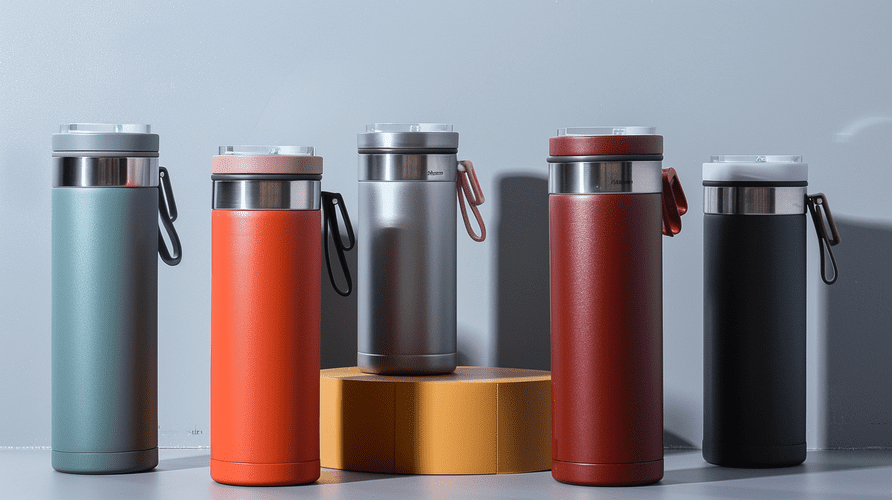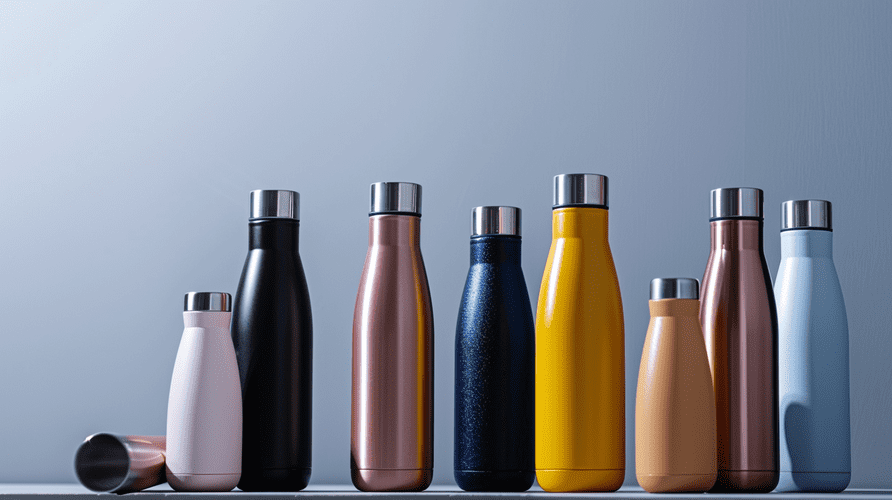Are you looking for promotional items that last and make a good impression? Cheap options often fail, hurting your brand. Stainless steel bottles offer a quality, eco-friendly solution your clients will appreciate.
Stainless steel bottles boost your brand with durability, eco-friendliness, and safety. They keep drinks hot or cold, are easy to clean, cost-effective long-term, and highly customizable for promotions or resale, offering great value.
Choosing the right products for your business is crucial. You want something that reflects your company's quality and values. It needs to be practical for your customers or employees, but also beneficial for your bottom line and brand image. That's why exploring the benefits of stainless steel drinkware is a smart move. Let's look deeper into why they are such a popular choice for businesses like yours.
What are the advantages of stainless steel water bottles?
Unsure if stainless steel bottles are worth the investment for your business? Choosing the wrong bottle impacts brand image and budget. Discover the clear advantages that make them a smart choice.
Key advantages include unmatched durability, temperature retention (hot/cold), health safety (BPA-free), environmental benefits, and excellent branding potential. They offer long-term value compared to plastic, enhancing your company's image.

As someone who works directly with these products every day in our factory, I see firsthand why businesses choose stainless steel. Let's break down those top benefits based on what procurement managers like Mark Shenng often focus on: quality, branding, and reliability.
1. Environmental Sustainability1
Plastic waste is a huge global problem. Choosing reusable stainless steel bottles significantly cuts down on single-use plastic consumption. This resonates well with environmentally conscious consumers and businesses. It shows your brand cares about sustainability, which is increasingly important for corporate image. For B2B clients, offering sustainable products can be a strong selling point.
2. Cost-Effectiveness2
While the initial cost might be higher than plastic, stainless steel bottles last for years. Think about how many cheap plastic bottles you'd buy (and throw away) in the time one good steel bottle lasts. For businesses giving these as gifts or using them internally, the long-term value is much better. Fewer replacements mean lower costs over time.
3. Durability and Longevity
These bottles are tough. Made from food-grade stainless steel (like 18/8 or 304), they resist rust, dents, and drops much better than plastic or glass. I've seen bottles accidentally dropped in our workshop that barely show a scratch. This durability means your branded item stays in use longer, keeping your logo visible.
4. Temperature Control
Most of our stainless steel bottles use double-wall vacuum insulation. This technology is excellent at keeping drinks cold for up to 24 hours or hot for up to 12 hours. It's a practical benefit users love, whether for coffee on the commute or cold water at the gym. This performance adds to the perceived value.
5. Health and Safety
Quality stainless steel is naturally BPA-free and doesn't leach harmful chemicals into drinks, unlike some plastics. There's no risk of chemical taste transfer either. This is a major selling point, especially for health-conscious users. Providing a safe product reflects well on your company's commitment to quality.
6. Customization and Branding3
The smooth surface of a stainless steel bottle is perfect for branding. We offer various customization options like laser engraving, screen printing, or full-color wraps. Your logo looks sharp and professional on steel, creating a high-quality promotional item or retail product. It turns a simple bottle into a powerful marketing tool.
7. Easy Maintenance and Cleaning
Stainless steel is non-porous and easy to clean. Most can be washed with simple soap and water, and many are dishwasher safe (though handwashing is often recommended for designs). They don't retain odors or flavors like some plastics can. Simple maintenance means users are more likely to keep using them.
8. Reduced Risk of Accidents
Unlike glass bottles, stainless steel won't shatter if dropped. This makes them safer for active use, commuting, or in workplaces. Less risk of breakage means fewer safety concerns and replacements.
9. Versatility
These bottles aren't just for water. They work great for coffee, tea, juice, smoothies, and more, thanks to their non-reactive nature and insulation. This versatility makes them useful in many different situations, increasing their appeal.
10. Enhanced Customer Experience
Giving a high-quality, useful item like a stainless steel bottle leaves a positive impression. Customers or employees appreciate gifts that are practical, durable, and look good. It enhances their experience with your brand, building loyalty and goodwill.
What not to put in a stainless steel bottle?
Worried about damaging your stainless steel bottles or affecting taste? Using them incorrectly can lead to ruined bottles or unpleasant drinks. Know what liquids you should probably avoid putting inside.
Avoid very acidic drinks4 for long storage (like undiluted lemon juice), highly carbonated beverages (pressure buildup), milk/dairy (bacterial growth if left warm), and sealing boiling liquids immediately (pressure). Stick mostly to water, coffee, tea.

Stainless steel is fantastic, very resilient stuff. We use high-quality food-grade steel (usually 18/8) which is designed to handle most everyday drinks perfectly. However, like any material, it has some limits or things it's best to avoid for optimal performance and longevity. Think of it like caring for any quality tool. Here’s a bit more detail on why certain things aren't ideal:
Acidity Concerns
While stainless steel is highly resistant to corrosion, extremely acidic liquids (think pure vinegar or undiluted lemon juice) left sitting for very long periods could potentially interact with the metal over time. It's generally not an issue for normal use like adding a slice of lemon to water or drinking juice. But storing highly acidic stuff for days or weeks isn't recommended, just to be safe and avoid any potential metallic taste.
Carbonation Issues
This is mostly about pressure. Sealing a fizzy drink inside creates pressure buildup. Best case, it might be hard to open the lid. Worst case, especially with temperature changes increasing pressure, the lid could pop off forcefully. The bottles aren't typically designed to hold pressure like a soda bottle. It's best to leave carbonated drinks for cups or containers made for them.
Dairy and Warmth
Milk and dairy products spoil quickly, especially when warm. Inside a sealed bottle, bacteria can multiply rapidly. This creates unpleasant odors that can be hard to clean out fully, and it's obviously a health concern. If you do carry milk, make sure it stays cold and clean the bottle very thoroughly immediately after use.
Very Hot Liquid Pressure
If you pour boiling hot liquid in and immediately seal the lid tightly, the steam creates pressure as it cools slightly. This can make the lid very difficult to unscrew later. It's always a good idea to let boiling liquids cool down for a minute or two before sealing the bottle.
A Note on Cleaning
Avoid using chlorine bleach or harsh, abrasive cleaners (like steel wool) on your stainless steel bottles. Bleach can damage the passive chromium oxide layer that protects the steel from rust. Abrasives can scratch the finish. Simple dish soap, warm water, and a bottle brush are usually all you need. For tough stains, baking soda or vinegar solutions can often work.
Is stainless steel the best water bottle?
Comparing bottle materials like plastic, glass, and aluminum? Making the wrong choice means sacrificing durability, safety, or insulation. See why stainless steel often comes out on top for overall value.
For overall performance, yes. Stainless steel excels in durability, insulation, health safety (BPA-free), and eco-friendliness5 compared to plastic. It's less fragile than glass and offers better insulation than aluminum.

"Best" can depend on specific needs, but when you look at the key factors most people and businesses care about – durability, safety, performance, sustainability, and branding potential – stainless steel6 consistently scores very high marks. As a manufacturer, I work with stainless steel daily, but I also understand the alternatives clients consider. Let's compare them directly:
Stainless Steel vs. Plastic
- Pros of Steel: Far more durable, won't easily crack or break. Excellent insulation (keeps drinks hot/cold). BPA-free and no chemical leaching. Highly reusable and recyclable, better for the environment. Higher perceived value for branding.
- Cons of Steel: Higher initial cost. Can be heavier than plastic.
- Plastic: Cheaper upfront, lightweight. But less durable, potential BPA/chemical concerns, poor insulation, contributes to plastic waste.
Stainless Steel vs. Glass
- Pros of Steel: Much more durable, won't shatter if dropped. Often lighter than glass. Usually offers insulation (glass typically doesn't).
- Cons of Steel: Not transparent (can't see liquid level easily).
- Glass: Inert (no taste transfer), transparent, recyclable. But heavy, extremely fragile, poor insulation, safety risk if broken.
Stainless Steel vs. Aluminum
- Pros of Steel: Generally more durable against dents/scratches. Often better insulation (especially double-wall vacuum). No need for liners (some aluminum bottles have liners that might contain BPA or degrade).
- Cons of Steel: Can be slightly heavier than aluminum.
- Aluminum: Lightweight, recyclable. But often requires an internal liner (potential issues), dents easily, usually offers less insulation than quality steel bottles.
Here's a quick comparison table:
| Feature | Stainless Steel | Plastic | Glass | Aluminum |
|---|---|---|---|---|
| Durability | Very High | Low-Medium | Low (Fragile) | Medium |
| Insulation | Good-Excellent | Poor | Poor | Poor-Fair |
| Health Safety | Excellent | Variable (BPA?) | Excellent | Good (Liner?) |
| Eco-Friendly | Excellent | Poor | Good | Good |
| Weight | Medium | Light | Heavy | Light |
| Cost (Initial) | Medium | Low | Low-Medium | Low-Medium |
| Branding | Excellent | Good | Fair | Good |
For business purposes, especially for promotional items or branded merchandise where longevity, perceived value, and safety are key, stainless steel usually provides the best overall package. It delivers a premium experience that reflects well on the brand.
How long should you use a stainless steel water bottle?
Wondering about the lifespan of stainless steel bottles? Replacing items frequently costs money and resources. Understand how long these durable bottles can actually last with reasonable care.
With proper care, a quality stainless steel water bottle can last for many years, potentially a decade or more. Its lifespan primarily depends on usage frequency and maintenance, not material degradation like plastic.

One of the biggest selling points of stainless steel bottles is their incredible durability and potential for long life. Unlike plastic bottles that can degrade, stain, retain odors, or easily break, stainless steel is built to last. I often talk to clients like Mark Shenng who appreciate products that offer long-term value rather than needing constant replacement.
Factors Affecting Lifespan
The bottle itself, the stainless steel part, can theoretically last almost indefinitely if not physically damaged. What usually limits the lifespan are other factors:
- Physical Damage: A major drop could potentially damage the vacuum seal on an insulated bottle, causing it to lose its insulating properties. Significant dents might make it unstable or affect the lid fit.
- Lost or Broken Parts: Lids, caps, or seals can get lost or damaged over time. Often, replacement parts are available, but sometimes it's easier to get a new bottle.
- Neglect/Improper Cleaning: While steel resists odors and stains well, consistently leaving drinks (especially sugary or dairy ones) inside without cleaning can eventually lead to buildup or persistent smells that are hard to remove. Severe neglect could theoretically lead to issues, though rust is very rare with quality 18/8 steel.
Signs It Might Be Time for Replacement
- Loss of Insulation: If your insulated bottle suddenly stops keeping drinks hot or cold, the vacuum seal is likely broken.
- Persistent Odors/Tastes: If deep cleaning doesn't remove smells or tastes from previous drinks.
- Visible Rust: Extremely rare, but if you see rust spots forming (ensure it's not just residue), it might indicate lower quality steel or damage to the protective layer.
- Damaged/Leaking Lid: If the lid is cracked, warped, or the seal is damaged causing leaks.
- Major Dents: If a dent makes the bottle unusable or unstable.
Extending Lifespan Through Care
Simple care makes a huge difference:
- Regular Cleaning: Wash with soap and water after each use, especially with liquids other than water. Use a bottle brush to reach the bottom.
- Avoid Dropping: While durable, preventing hard impacts helps maintain the vacuum seal and appearance.
- Use Proper Cleaners: Avoid bleach and abrasive scouring pads.
- Check Seals: Occasionally inspect silicone seals in the lid for wear or tear.
From a business perspective, investing in quality stainless steel bottles means providing an item that can serve your customer or employee reliably for years, constantly reinforcing your brand message. The cost per year of use is incredibly low compared to alternatives.
Conclusion
Stainless steel bottles are a top choice: durable, safe, eco-friendly, great for branding, and offer excellent long-term value for any business. They keep drinks at the right temperature for hours.
-
Explore how environmental sustainability can enhance your brand's image and attract eco-conscious consumers. ↩
-
Understanding cost-effectiveness can help you make smarter investment choices for long-term savings. ↩
-
Learn how effective branding and customization can elevate your marketing strategy and customer engagement. ↩
-
Understanding the impact of acidic drinks can help you maintain your stainless steel bottles and avoid unpleasant tastes. ↩
-
Learn how stainless steel water bottles contribute to sustainability and reduce plastic waste, making them a better choice for the environment. ↩
-
Explore the advantages of stainless steel water bottles, including durability, safety, and eco-friendliness, to make an informed choice. ↩

